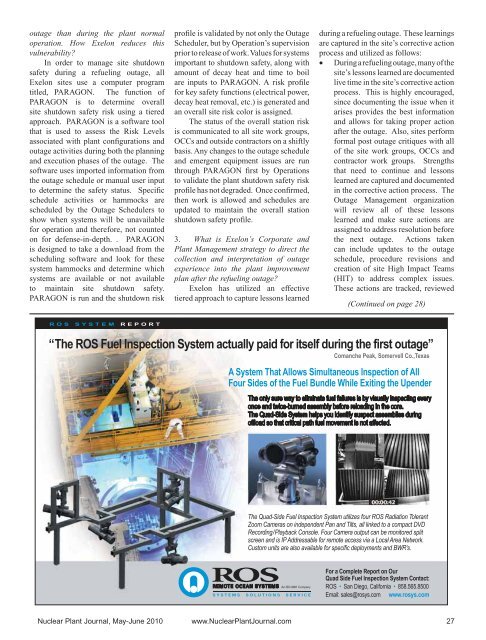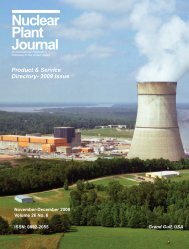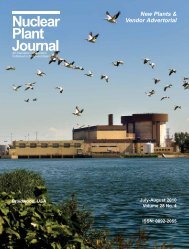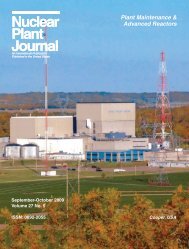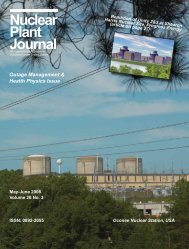New Energy - Digital Versions - Nuclear Plant Journal
New Energy - Digital Versions - Nuclear Plant Journal
New Energy - Digital Versions - Nuclear Plant Journal
Create successful ePaper yourself
Turn your PDF publications into a flip-book with our unique Google optimized e-Paper software.
outage than during the plant normal<br />
operation. How Exelon reduces this<br />
vulnerability?<br />
In order to manage site shutdown<br />
safety during a refueling outage, all<br />
Exelon sites use a computer program<br />
titled, PARAGON. The function of<br />
PARAGON is to determine overall<br />
site shutdown safety risk using a tiered<br />
approach. PARAGON is a software tool<br />
that is used to assess the Risk Levels<br />
associated with plant configurations and<br />
outage activities during both the planning<br />
and execution phases of the outage. The<br />
software uses imported information from<br />
the outage schedule or manual user input<br />
to determine the safety status. Specific<br />
schedule activities or hammocks are<br />
scheduled by the Outage Schedulers to<br />
show when systems will be unavailable<br />
for operation and therefore, not counted<br />
on for defense-in-depth. . PARAGON<br />
is designed to take a download from the<br />
scheduling software and look for these<br />
system hammocks and determine which<br />
systems are available or not available<br />
to maintain site shutdown safety.<br />
PARAGON is run and the shutdown risk<br />
profile is validated by not only the Outage<br />
Scheduler, but by Operation’s supervision<br />
prior to release of work. Values for systems<br />
important to shutdown safety, along with<br />
amount of decay heat and time to boil<br />
are inputs to PARAGON. A risk profile<br />
for key safety functions (electrical power,<br />
decay heat removal, etc.) is generated and<br />
an overall site risk color is assigned.<br />
The status of the overall station risk<br />
is communicated to all site work groups,<br />
OCCs and outside contractors on a shiftly<br />
basis. Any changes to the outage schedule<br />
and emergent equipment issues are run<br />
through PARAGON first by Operations<br />
to validate the plant shutdown safety risk<br />
profile has not degraded. Once confirmed,<br />
then work is allowed and schedules are<br />
updated to maintain the overall station<br />
shutdown safety profile.<br />
3. What is Exelon’s Corporate and<br />
<strong>Plant</strong> Management strategy to direct the<br />
collection and interpretation of outage<br />
experience into the plant improvement<br />
plan after the refueling outage?<br />
Exelon has utilized an effective<br />
tiered approach to capture lessons learned<br />
during a refueling outage. These learnings<br />
are captured in the site’s corrective action<br />
process and utilized as follows:<br />
• During a refueling outage, many of the<br />
site’s lessons learned are documented<br />
live time in the site’s corrective action<br />
process. This is highly encouraged,<br />
since documenting the issue when it<br />
arises provides the best information<br />
and allows for taking proper action<br />
after the outage. Also, sites perform<br />
formal post outage critiques with all<br />
of the site work groups, OCCs and<br />
contractor work groups. Strengths<br />
that need to continue and lessons<br />
learned are captured and documented<br />
in the corrective action process. The<br />
Outage Management organization<br />
will review all of these lessons<br />
learned and make sure actions are<br />
assigned to address resolution before<br />
the next outage. Actions taken<br />
can include updates to the outage<br />
schedule, procedure revisions and<br />
creation of site High Impact Teams<br />
(HIT) to address complex issues.<br />
These actions are tracked, reviewed<br />
(Continued on page 28)<br />
<strong>Nuclear</strong> <strong>Plant</strong> <strong>Journal</strong>, May-June 2010 www.<strong>Nuclear</strong><strong>Plant</strong><strong>Journal</strong>.com 27


